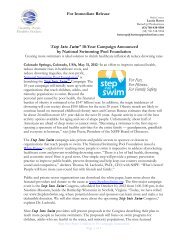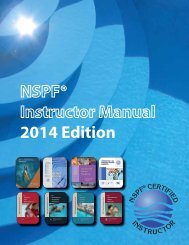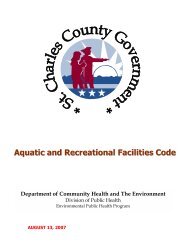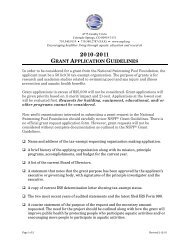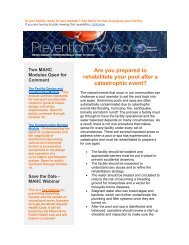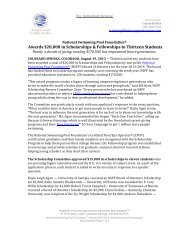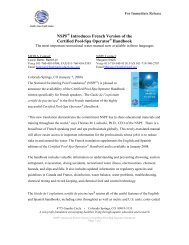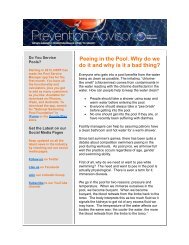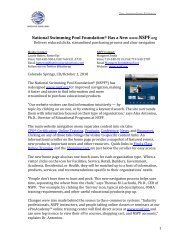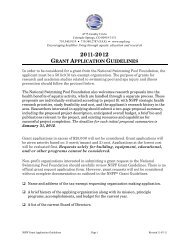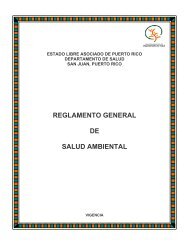English Instructor Manual (PDF) - Metric Version - National ...
English Instructor Manual (PDF) - Metric Version - National ...
English Instructor Manual (PDF) - Metric Version - National ...
You also want an ePaper? Increase the reach of your titles
YUMPU automatically turns print PDFs into web optimized ePapers that Google loves.
Hypersensitivity Pneumonitis (HP)<br />
Methicillin-Resistant Staphylococcus aureus (MRSA)<br />
Mollusum Contagiosum<br />
Plantar warts<br />
Athlete’s foot<br />
Key Points: Emphasize that good pool operating procedures and educating swimmers and<br />
parents are the best ways to prevent accidental contamination before it happens. These include:<br />
Maintain proper disinfectant levels at all times. Drops in levels are an invitation for<br />
bacteria to spread in the pool water.<br />
Have all children use the bathroom before entering the pool. Have designated<br />
changing areas away from the deck or seating area. Swim diapers and rubber pants do<br />
not prevent contamination. They only provide containment for a short period of time.<br />
Require every swimmer to shower before entering the pool. Doing so will remove<br />
contaminated substances that may spread diseases in the pool water. In many states,<br />
this is a regulation.<br />
Prohibit pool use for people with open wounds/sores or known infections. Since<br />
open wounds and sores eliminate the natural barrier that skin provides against disease<br />
transmission, people with open wounds and sores can both transmit and receive<br />
contamination more easily than people without these problems.<br />
Work with local and state health departments.<br />
Other Pool Water Health Concerns<br />
Key Point: Discuss disinfection by-products production and means of controlling them. Include:<br />
How to minimize DBPs. Use of ozone, ultraviolet and chlorine dioxide with chlorine or<br />
bromine.<br />
Give a brief description of Trihalomethanes (THMs) and their production in pool water.<br />
Key Point: Discuss Bromine itch and its two causes and how to minimize its occurrence.<br />
Additional Training: Suggest that students enroll and take the Advanced RWI online training<br />
course from NSPF. Alternatively, offer to teach the classroom version of the course.<br />
Final Questions: Ask the participants if they have any questions pertaining to the lesson they<br />
have just completed. If there are participants who are still having trouble with the concepts of this<br />
lesson, offer additional help during a break or after class.<br />
NOTE: Recommend the RWI online/classroom training course and handbook for additional<br />
training.<br />
© 2014 <strong>National</strong> Swimming Pool Foundation® Page 51



